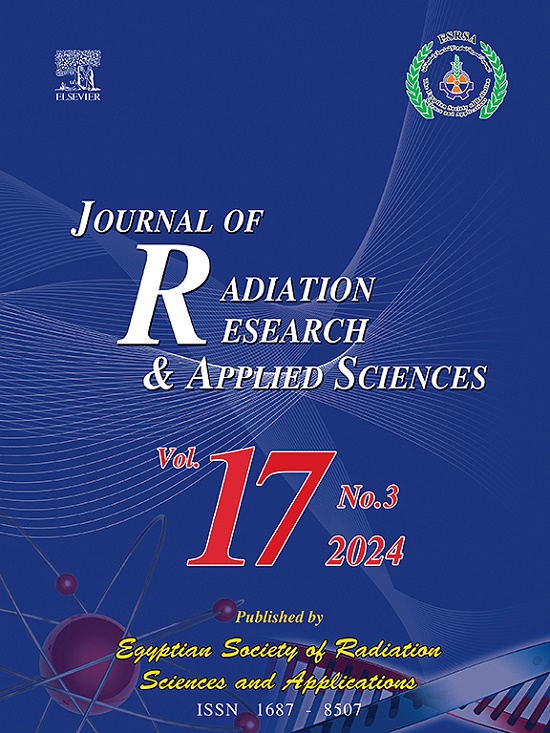Thermally Darcy-Forchheimer flow of tri-hybrid nanomaterials with temperature-dependent fluid characteristics
IF 1.7
4区 综合性期刊
Q2 MULTIDISCIPLINARY SCIENCES
Journal of Radiation Research and Applied Sciences
Pub Date : 2025-03-17
DOI:10.1016/j.jrras.2025.101404
引用次数: 0
Abstract
Trihybrid nanofluids (THNF) are prepared by combining three distinct types of nanoparticles in a regular fluid to improve the heat efficiency of fluid in several fields, including electronics cooling, solar energy, heat exchangers, automobile radiators, biomedicine, and solar power systems. Further, Darcy-Forchheimer flow through porous materials is widely used in distinct industrial and manufacturing processes, such as waste storage, foam and ceramics, oil purification, food processing, and many others. In line with this, explore the heat transfer characteristics of the magnetized ternary hybrid nanofluid flow of the Darcy-Forchheimer model over a porous shrinking horizontal cylinder incorporating variable thermal conductivity, thermal radiation and Joule heating with first-order velocity and thermal slip conditions. The leading equations are reform into dimensionless notation by using the application of similarity transformations. We altered a non-dimensional set of ordinary differential equations using the numerical method, namely MATLAB function bvp4c. Graphical and tabular analyses are carried out for the emergent variables against drag friction, heat transportation rate, flow field, and thermal distribution. Dual solution obtained under specific ranges of several physical factors. The major outcome reveals that drag friction efficiency of the ternary hybrid nanofluid is more superior than that of the hybrid nanofluid and simple nanofluid. Histrogram analysis also reveal that friction force improved with the increment in tri-hybrid nanofluid for stable branch solution. The variation in the velocity slip factor increases the velocity field. Furthermore, heat transport rate boosts with the variation of suction factor. Additionally, thermal distribution is also enhanced with an increment in the thermal slip parameter and variable thermal conductivity factor. This model of tri-hybrid nanofluid with stretching (shrinking) cases has numerous daily life applications such as X-ray process, bundle wrapping, cooling of thermal reactors, tumor therapy, hot roll, laser diodes, heat exchangers, cooling of gadgets, nuclear fusion, sheet material extrusion, polymer production, pharmaceuticals, sheet material extrusion, computer chips, aluminum bottles manufacturing, turbine blades, hybrid vehicles, and many others.
具有温度依赖流体特性的三杂化纳米材料的热Darcy-Forchheimer流动
三杂交纳米流体(THNF)是将三种不同类型的纳米颗粒结合在常规流体中制备而成的,用于提高电子冷却、太阳能、热交换器、汽车散热器、生物医学和太阳能发电系统等多个领域的流体热效率。此外,通过多孔材料的达西-福希海默流被广泛应用于不同的工业和制造过程,如废物储存,泡沫和陶瓷,油净化,食品加工等。在此基础上,探讨了Darcy-Forchheimer模型中磁化三元混合纳米流体在含一阶速度和热滑移条件下可变导热系数、热辐射和焦耳加热的多孔收缩水平圆柱体上的传热特性。利用相似变换将前导方程转化为无量纲符号。我们使用数值方法,即MATLAB函数bvp4c,改变了一组无量纲常微分方程。对阻力摩擦、热输运率、流场和热分布等紧急变量进行了图形和表格分析。在若干物理因素的特定范围内得到对偶解。主要结果表明,三元复合纳米流体的阻力摩擦效率优于混合纳米流体和单一纳米流体。直方图分析还表明,对于稳定的分支溶液,摩擦力随三杂化纳米流体加入量的增加而增加。速度滑移系数的变化使速度场增大。随着吸力系数的变化,传热速率也随之增大。此外,随着热滑移参数和变导热系数的增加,热分布也会增强。这种具有拉伸(收缩)外壳的三混合纳米流体模型在日常生活中有许多应用,如x射线加工、束包装、热反应堆冷却、肿瘤治疗、热轧、激光二极管、热交换器、小工具冷却、核聚变、片状材料挤压、聚合物生产、制药、片状材料挤压、计算机芯片、铝瓶制造、涡轮叶片、混合动力汽车等。
本文章由计算机程序翻译,如有差异,请以英文原文为准。
求助全文
约1分钟内获得全文
求助全文
来源期刊

Journal of Radiation Research and Applied Sciences
MULTIDISCIPLINARY SCIENCES-
自引率
5.90%
发文量
130
审稿时长
16 weeks
期刊介绍:
Journal of Radiation Research and Applied Sciences provides a high quality medium for the publication of substantial, original and scientific and technological papers on the development and applications of nuclear, radiation and isotopes in biology, medicine, drugs, biochemistry, microbiology, agriculture, entomology, food technology, chemistry, physics, solid states, engineering, environmental and applied sciences.
 求助内容:
求助内容: 应助结果提醒方式:
应助结果提醒方式:


